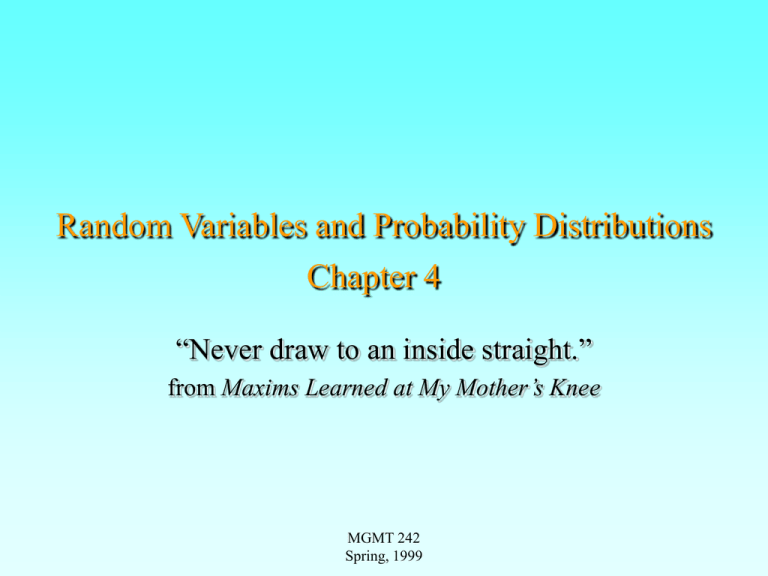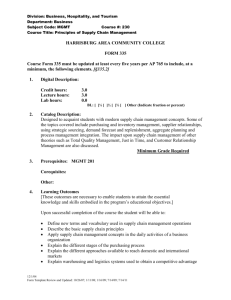Probability Essentials Chapter 3
advertisement

Random Variables and Probability Distributions
Chapter 4
“Never draw to an inside straight.”
from Maxims Learned at My Mother’s Knee
MGMT 242
Spring, 1999
Goals for Chapter 4
• Define Random Variable, Probability Distribution
• Understand and Calculate Expected Value
• Understand and Calculate Variance, Standard
Deviation
• Two Random Variables--Understand
– Statistical Independence of Two Random Variables
– Covariance & Correlation of Two Random Variables
• Applications of the Above
MGMT 242
Spring, 1999
Random Variables
• Refers to possible numerical values that will be the
outcome of an experiment or trial and that will vary
randomly;
• Notation: uppercase letters for last part of alphabet--X,
Y, Z
• Derived from hypothetical population (infinite
number), the members of which will have different
values of the random variable
• Example--let Y = height of females between 18 and 20
years of age; population is infinite number of females
between 18 and 20
• Actual measurements are carried out on a sample,
which is randomly chosen from population.
MGMT 242
Spring, 1999
Probability Distributions
• A probability distribution gives the probability for
a specific value of the random variable:
– P(Y= y) gives the probability distribution when values for P
are specified for specific values of y
– example: tossed a coin twice(fair coin); Y is the number of
heads that are tossed; possible events: TT, TH, HT, HH;
each event is equally probable if coin is a fair coin, so
probability of Y=0 (event: TT) is 1/4; probability of Y =2 is
1/4; probability of Y = 1 is 1/4 +1/4 = 1/2;
– Thus, for example:
• P(Y=0) = 1/4
• P(Y=1) = 1/2
• P(Y=2) = 1/4
MGMT 242
Spring, 1999
Probability Distributions--Discrete Variables
• Notation: P(Y=y) or, occasionally, PY(y) (with y
being some specific value;
• PY(y) is some value when Y=y and 0 otherwise
• Example--(Ex. 4.1) 8 people in a business group, 5
men, 3 women. Two people sent out on a recruiting
trip. If people randomly chosen, find PY(y) for Y
being the number of women sent out on the recruiting
trip.
• Solution (see board work):
PY(2) = 3/28; PY(1) = 15/28; PY(0) = 10 /28
MGMT 242
Spring, 1999
Cumulative Probability Distribution-Discrete Variables
• Notation: P(Y y) means the probability that Y is less
than or equal to y; FY(y) is the same.
• Complement rule: P(Y > y) = 1 - FY(y).
• Example (previous scenario, 5 men, 3 women,
interview trips). What is the probability that at least
one woman will be sent on an interview trip? (Note:
“at least” means 1 or greater than 1)
– = P (Y> 0) = 1 - FY(0) = 1 - PY(0) = 1 - 10/28 = 18/28
– In this example, it’s just as easy to calculate
P(Y 1) = P(Y=1) + P(Y=2) = 15 /28 + 3 / 28, but many times it’s
not as easy.
MGMT 242
Spring, 1999
Expectation Values, Mean Values
• The expectation value of a discrete random variable
Y is defined by the relation E(Y) = iPY( yi) yi ,
that is to say, the sum of all possible values of Y,
with each value weighted by the probability of the
value.
• Note that E(Y) is the mean value of Y; E(Y) is
also denoted as < Y > .
• Example (for previous case, 8 people, 5 men, 3
women,…) If Y is the number of women on an
interview trip (Y= 0, 1, or 2), then
E(Y) = (3/28) x 2 + (15/28) x 1 + (10/28)x0 =21/28 = 3/4
MGMT 242
Spring, 1999
Variance of a Discrete Random Variable
• The variance of a discrete random variable, V(Y), is
the expectation of the square of the deviation from the
mean (expected value); V(Y) is also denoted as Var(Y)
• V(Y) = E[(Y- E(Y))2] = iPY( yi) [yi - E(Y)]2 ;
• V(Y) = E(Y2) - (E(Y))2
• The second formula for V(Y) is derived as follows:
– V(Y) = iPY( yi) [yi2 - 2 yi E(y) + (E(Y))2]
– or V(Y) = E(Y2) - 2 E(y) E(y) + (E(Y))2 = E(Y2) - (E(Y))2
• Example (previous, 5 men, 3 women, etc..)
– V(Y) = {(3/28)(2- 3/4)2 + (15/28) (1- 3/4)2 + (10/28) (0- 3/4)2,
or V(Y) = (3/28) 22 + (15/28) 12 + 0 - (3/4)2 = 27/28
MGMT 242
Spring, 1999
Expectation Values--Another Example
Exercise 4.25, Investment in 2 Apartment Houses
Return
-50
0
50
100
150
200
250
exp.val.
variance
st.dev.
House1 Probs.
House2 Probs.
exp1 termsvar1 terms
0.02
0.15
-1
450
0.03
0.1
0
300
0.2
0.1
10
500
0.5
0.1
50
0
0.2
0.3
30
500
0.03
0.2
6
300
0.02
0.05
5
450
sum exp1 sum var1
100
105
100
2500
2500
8475
50 92.05976
MGMT 242
Spring, 1999
Continuous Random Variables
• Reasons for using a continuous variable rather
than discrete
– Many, many values (e.g. salaries)--too many to take as
discrete;
– Model for probability distribution makes it convenient or
necessary to use a continuous variable-• Uniform Distribution (any value between set limits equally
likely)
• Exponential Distribution (waiting times, delay times)
• Normal (Gaussian) Distribution, the “Bell Shaped Curve”
(many measurement values follow a normal distribution either
directly or after an appropriate transformation of variables; also
mean values of samples follow a normal distribution,
generally.)
MGMT 242
Spring, 1999
Probability Density and Cumulative
Density Functions for Continuous Variables
• Probability density function, fX(x) defined:
– P(x X x+dx) = fX(x) dx, that is, the probability that
the random variable X is between x and x+dx is given by
fX(x) dx
• Cumulative density function, FX(x), defined:
– P(X x ) = FX(x)
– FX(x’) = fX(x)dx, where the integral is taken from the
lowest possible value of the random variable X to the
value x’.
MGMT 242
Spring, 1999
Probability Density and Cumulative Density
Functions for Continuous Variables,
Example: Exercise 4.12
• Model for time, t, between successive job applications
to a large computer is given by FT(t) = 1 - exp(-0.5t).
• Note that FT(t) = 0 for t =0 and that FT(t) approaches 1
for t approaching infinity.
• Also, fT(t) = the derivative of FT(t), or
fT(t) = 0.5exp(-0.5t)
MGMT 242
Spring, 1999
Probability Density and Cumulative Density
Functions for Continuous Variables-Example, Problem 4.12
FsubY
1.2
1
0.8
0.6
0.4
0.2
0
0
2
4
6
MGMT 242
Spring, 1999
8
10
12
Expectation Values for Continuous Variables
• The expectation value for a continuous
variable is taken by weighting the quantity by
the probability density function, fY(y), and
then integrating over the range of the random
variable
• E(Y) = y fY(y) dy;
– E(Y), the mean value of Y, is also denoted as Y
• E(Y2) = y fY(y) dy;
• The variance is given by V(Y) = E(Y2) - (Y)2
MGMT 242
Spring, 1999
Continuous Variables--Example
• Ex. 4.18, text. An investment company is going to sell
excess time on its computer; it has determined that a good
model for the its own computer usage is given by the
probability density function
fY(y) = 0.0009375[40-0.1(y-100)2 ] for 80 < y < 120
fY(y) = 0, otherwise.
The important things to note about this distribution function
can be determined by inspection
– there is a maximum in fY(y) at y = 100
– fY(y) is 0 at y=80 and y = 120
– fY(y) is symmetric about y=100 (therefore E(y) = 100 and
FY(y)=1/2 at y = 100).
– fY(y) is a curve that looks like a symmetric hump.
MGMT 242
Spring, 1999
Two Random Variables
• The situation with two random variables, X and Y, is
important because the analysis will often show if there is
a relation between the two, for example, between height
and weight; years of education and income; blood
alcohol level and reaction time.
• We will be concerned primarily with the quantities that
show how strong (or weak) the relation is between X
and Y:
– The covariance of X and Y is defined by
Cov(X,Y)
= E[(X-X)(Y- Y)] = E(XY) -XY
– The correlation of X and Y is defined by
Cor(X,Y) = Cov(X,Y) / (V(X)V(Y) = Cov(X,Y)/(X Y)
MGMT 242
Spring, 1999
Properties of Covariance, Correlation
• Cov(X,Y) is positive (>0) if X and Y both increase or both
decrease together; Examples:
– height and weight; years of education and salary;
• Cov(X,Y) is zero if X and Y are statistically independent:
[Cov(X,Y) = E(XY) -XY= E(X)E(Y)-XY = XY - XY= 0]
Examples: adult hat size and IQ;
• Cov(X,Y) is negative if Y increases while X decreases;
Example:
– annual income, number of bowling games per year.
(no disrespect meant to bowlers).
MGMT 242
Spring, 1999
Statistical Independence of Two
Random Variables
• If two random variables, X and Y, are statistically
independent, then
– P(X=x, Y=y) = P(X=x) P(Y=y),
that is to say, the joint probability density function can be
written as the product of probability density functions for X
and Y.
– Cov(X, Y) = 0
This follows from the above relation:
Cov(X,Y) = E[(X-µX) (Y-µY)] =[E(X-µX)][E(Y-µY)]
= (µX-µX) (µY-µY) = 0
MGMT 242
Spring, 1999






